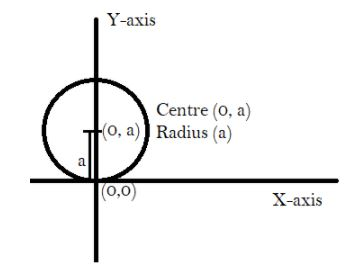Question
Question: Draw the circle whose equation is \[{x^2} + {y^2} = 2ay\]....
Draw the circle whose equation is x2+y2=2ay.
Solution
Before attempting this question, one should have prior knowledge about the circle and also remember that the equation of circle in standard form can easily give the center in form (h, k) and radius r, use this information to approach the solution of the problem.
The general equation is (x−h)2+(y−k)2=r2
Complete step-by-step answer:
Given: An equation of circle x2+y2=2ay, we need to draw the given circle. But we neither have a center or radius. The standard form of circle with center (h, k) and radius is given by the equation, (x−h)2+(y−k)2=r2
We need to convert the given equation in standard form in order to draw it. Let’s begin with bringing all terms to the left-hand side.
x2+y2=2ay
x2+y2−2ay=0
Since, we need to make a square in form (x−h)2 and (y−k)2 . Add the a2 term to both sides.
x2+y2+a2−2ay=a2
Using the algebraic identity (a−b)2=a2+b2−2ab in the above equation we get
(x−0)2+(y−a)2=a2
Hence, on comparing with the standard form we have center (0, a) and radius equal to a.

We located the center (0, a) and drew a circle with taking radius ‘a’.
Note: In the above question we came across the term “circle” which can be explained as the collection of points exist in the same plane where every point is equidistant from a point which is named as the center point, in the circle radius is the defined distance from the point on the circumference of the circle. The general form of the equation of circle is given as x2+y2 + Dx+Ey+F=0, where D, E and F are constants.
